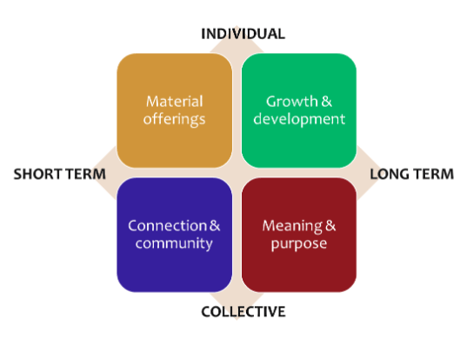Positioning Leadership at the Core: Fostering an Engaged Workforce
Harvard Business Review (HBR) published a January-February 2023 issue titled, "What Most Companies Get Wrong About Managing Talent." A feature article in the issue by Mark Mortensen and Amy C. Edmondson called "Rethink Your Employee Value Proposition: Offer Your People More Than Just Flexibility" discussed an employee value proposition composed of four interrelated factors.
These four factors (material offerings, opportunities to develop and grow, connections and community, and meaning and purpose) can be plotted on two dimensions: short-term versus long-term, and individual versus the collective, as shown below:

The authors point out that there is not one best answer to engage and retain an individual employee or the employee group as a whole. They note that a systematic and holistic approach is required. They also outline three steps that leaders can take to move this approach forward: assess what your company has and what your employees need; change the conversation; and continually update.
This article outlines a thoughtful systemic view of how organizations can create engaged and connected employees, and what leaders can do to assist with this. The framework and concepts can and should be enriched, however, by putting leadership at the center of this framework as shown below:

There are several reasons for highlighting the importance of this inclusion.
The article notes the three steps leaders can take to enhance a company's systemic approach. It does not highlight the research noting that it is leadership that has the greatest impact on the engagement and connection of employees.
As such, leadership and each individual leader are responsible for holding themselves to a higher standard. They are responsible for understanding and delivering what employees need from them. For example, there is a wealth of engagement research that reveals things that leaders need to do to strengthen engagement (e.g., be clear about expectations).
Leaders also make the connections in the Mortensen and Edmondson framework clearer (or not) for employees between short-term and long-term and between the individual and the collective. For example, leaders should clarify how the employee’s role and outcomes connects to team and organizational outcomes. Leaders should be proactive influencers in the organization helping to ensure that both short-term and long-term motivators exist for the organization, for teams, and for individuals.
Leaders also have the responsibility for modeling growth and development, connection and community, and meaning and purpose themselves. Employees will learn from this. Leaders will gain credibility, awareness, and fulfillment from it.
Even in the material offerings, leaders should be aware of any distinctions that exist between leadership/leader offerings and employee offerings. Things like physical office space, flexibility, and schedules can say a great deal about a leader's values and can have an impact on employee engagement.
Perhaps, most importantly, leaders need to make sure that they are engaged. Who can expect employees to be engaged if leaders are not?
In summary, leaders can realize tremendous value from the framework presented by Mortensen and Edmondson. To extend this value so much further, they need to place themselves dead center of creating an engaged and connected employee base. If they don't, they have much to lose.



